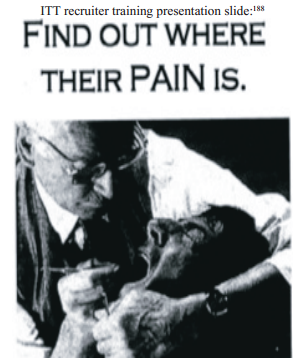(1)
(2) U.S. Senate. HEALTH, EDUCATION, LABOR AND
PENSIONS COMMITTEE. For Profit Higher
Education: The Failure to Safeguard the Federal Investment and Ensure Student
Success (1-181). Washington: Government Printing Office, July. 2012
(3) The US Senate's HELP committee researched
the deceptive tactics that for-profits used during their enrollment process.
Their results show that for-profits will go to extreme lengths to recruit
students, including targeting the most vulnerable parts of the population.
(4) The US HELP committee is a portion of the
Senate. It handles manners concerning the health, education, and work force of
the nation.
(5) Pain Funnel - sales tactic used by
for-profit recruiters that elicits pain in students, causing them to make decisions
without much thought
Objections - doubts or concerns students
may have about enrollment. Recruiters used scripts or aggressive language to
overcome student objections.
(6) "After a recruiter located a
prospective student’s pain point, the “pain funnel” presented a number
of
questions that the recruiter can ask that are progressively more hurtful"
(HELP 62).
Students
are mentally backed into a corner with the pain funnel method. Then, recruiters
would offer the solutions to all of the students' problems in the form of a
for-profit degree.
"For
instance, Vatterott’s internal “Student Profiles,” part of a manual to train recruiters,
detailed the demographic subgroups that the company targets for enrollment:
'Welfare Mom w/Kids. Pregnant Ladies. Recent Divorce. Low Self-Esteem. Low
Income Jobs. Experienced a Recent Death. Physically/Mentally Abused. Recent
Incarceration. Drug Rehabilitation. Dead-End Jobs-No Future'"(HELP 58).
Low-income
and minority populations are targeted by these companies, and recruiters are
trained to find and take advantage of students who fit the description.
"An
internal Concorde email indicates that company employees had visited 'welfare
offices' and 'unemployment offices,' although recruiters were later told to
stop visiting these offices because it may be a violation of accreditation
standards" (HELP 58).
In their
attempt to exploit low-income neighborhoods and find prospective students, some
recruiters have been known to show up at social service organization offering for-profit
education as solutions to vulnerable people.
(7) This study explicitly shows the methods
used by for-profit college in their efforts to take advantage of the low-income
communities. Students are pushed to the edge, emotionally, and then offered a
solution in for-profit education. If students do not comply, they are met with
more aggressive methods of recruitment.

No comments:
Post a Comment